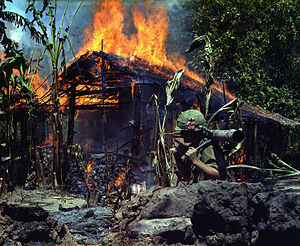
Asymmetric warfare
A war between belligerents whose relative military power differs significantly / From Wikipedia, the free encyclopedia
Dear Wikiwand AI, let's keep it short by simply answering these key questions:
Can you list the top facts and stats about Asymmetric warfare?
Summarize this article for a 10 years old
Asymmetric warfare (or asymmetric engagement) is a type of war between belligerents whose relative military power, strategy, or tactics differ significantly. This type of warfare often, but not necessarily, involves insurgents or resistance movement militias who may have the status of unlawful combatants against a standing army. [1]

| Part of a series on |
| War |
|---|
|
Asymmetrical warfare can also describe a conflict in which belligerents' resources are uneven, and consequently, they both may attempt to exploit each other's relative weaknesses. Such struggles often involve unconventional warfare, with the weaker side attempting to use strategy to offset deficiencies in the quantity or quality of their forces and equipment.[2] Such strategies may not necessarily be militarized.[3] This is in contrast to symmetrical warfare, where two powers have comparable military power, resources, and rely on similar tactics.
Asymmetric warfare is a form of irregular warfare – conflicts in which enemy combatants are not regular military forces of nation-states. The term is frequently used to describe what is also called guerrilla warfare, insurgency, counterinsurgency, rebellion, terrorism, and counterterrorism.